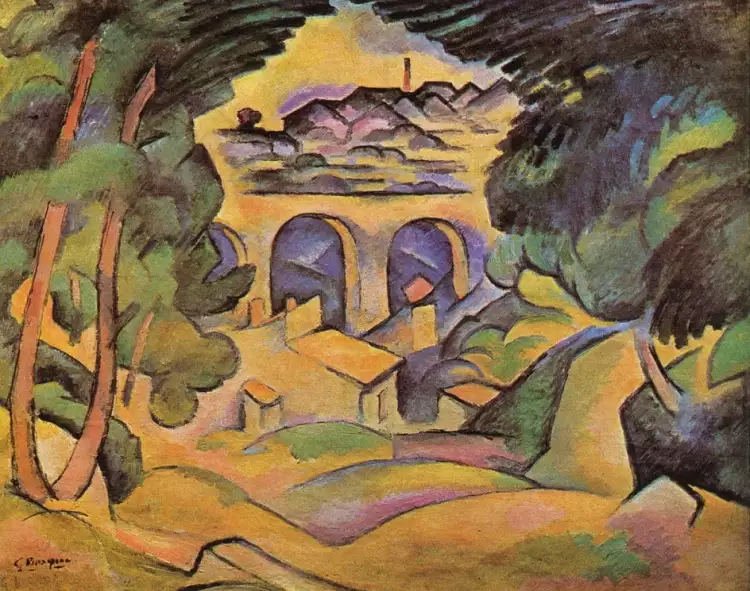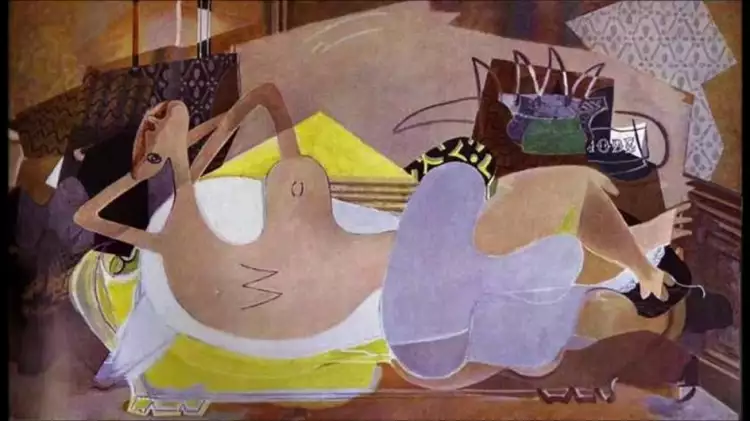
Georges Braque - the founder of Cubism in world art
Georges Braque (born May 13, 1882 - died August 31, 1963) was an outstanding French artist of the first half of the 20th century, a co-founder of Cubism and the collage technique in world painting. He created a new way of seeing the world and laid the foundation for modern art. Georges Braque's paintings are characterized by a unique sense of measure and style, aesthetic integrity, and harmony. In his biography, there are many glorious stages of work as a decorator, engraver, and sculptor. However, the main direction of the great master's work was painting.
 Georges Braque. Artist's photograph, year of creation unknown
Georges Braque. Artist's photograph, year of creation unknown
Georges Braque sometimes admitted, "I created Cubism without realizing it myself." His bold innovations, which provoked a crisis in traditional painting, matched the scale of his talent. But the master himself in his creative quest was never a wild improviser or a fanciful colorist. He always skillfully restrained and moderated his emotions.
 Georges Braque. Fruit platter and glass, 1912
Georges Braque. Fruit platter and glass, 1912
Georges Braque's Biography
Georges Braque was born on May 13, 1882, in Argenteuil, a northwestern suburb of Paris, in the family of a local decorator. In 1890, together with his parents, he moved to the north of France, to the coastal town of Le Havre, where, in his characteristic youthful carelessness, he actively skipped school lessons and immersed himself in the bustling life of the port city.
 Georges Braque. Grandmother's friend, 1900
Georges Braque. Grandmother's friend, 1900
In 1897, at the age of 15, Georges began attending evening classes at the School of Fine Arts. In his free time, he walked along the quayside and made his first sketches. However, his youthful talent did not have an inclination for academic painting canons, and two years later, he failed the baccalaureate exam, disrupting the perspective by incorrectly composing the composition and the light-shadow model.
 Georges Braque. A ship in Le Havre, 1905
Georges Braque. A ship in Le Havre, 1905
Nevertheless, the desire to become a decorator-artist did not leave Georges. In 1900, he went to Paris and entered the Academy of Humbert, and after its completion in 1902, he enrolled in the School of Fine Arts in Paris. He regularly visited the Louvre's exhibition halls, admired the paintings of Vincent Willem van Gogh, Jean-Baptiste Camille Corot and Nicolas Poussin.
 Georges Braque. Terrace of the Hotel Mistral in Estaque, 1907
Georges Braque. Terrace of the Hotel Mistral in Estaque, 1907
Georges Braque painted early landscapes in an Impressionist style. However, by 1906, he became influenced by Fauvism with its boundless freedom of self-expression, adopting the styles of Henri Matisse and André Derain. A few months later, he exhibited at the Salon des Indépendants.
 Georges Braque. Viaduct in Estaque, 1908
Georges Braque. Viaduct in Estaque, 1908
It was during this time that he had a fateful encounter with Pablo Picasso, after which Georges drastically changed his painting style. Inspired and united by the works of Paul Cézanne, the young artists aimed for concise painting and the geometrization of details. From 1908 to 1914, they diligently worked on the theoretical and practical foundations of Cubism. Almost simultaneously, they invented collages, explaining the new idea as a "search for relief without the deception of vision."
 Georges Braque. Woman with mandolin, 1910
Georges Braque. Woman with mandolin, 1910
Georges Braque's paintings acquired a more muted and restrained palette, and his painting style began to feature fragmentations of forms into small facets, resembling a mosaic, where the outlines of objects were barely recognizable. The audience's task became more challenging as they had to assemble a whole from many small parts. Cubist paintings became interpretations of reality, offering multiple ways to engage in intellectual play with the viewer.
 Georges Braque. Lying nude, 1932
Georges Braque. Lying nude, 1932
The creative enthusiasm of the collaboration between these two talented artists was interrupted by World War I. Georges Braque was mobilized, sent to the front, and severely wounded. This event became a critical turning point that divided the painter's life and creativity into two periods: before and after.
 Georges Braque. Artist and his model, 1939
Georges Braque. Artist and his model, 1939
Starting from the 1920s, the master's style changed. Braque abandoned sharp angular forms in favor of smooth, curved lines. The color palette became lighter. Figures of people in realistic surroundings appeared in his compositions. Cubist forms were skillfully woven into the canvas of expressionism.
The great master passed away on August 31, 1963, in Paris, at the age of 81.
Georges Braque's Most Famous Paintings
Masterpieces created in various styles and techniques by the artist captivate art enthusiasts around the world. Here are just some of the most famous paintings by Georges Braque:
- "Olive Tree near Estaque" (1906) - a landscape in the Fauvist style with simplified forms and bright emotional spots.
- "Violin and Palette" (1909) - a still life featuring a musical instrument, one of the artist's favorite subjects, fragmented like pieces of a puzzle.
- "Château La Roche-Guyon" (1909) - a voluminous architectural structure depicted during the proto-Cubist period, preceding Cubism; it lacks elements of figurative painting but retains a tactile effect.
- "Round Table" (1929) - reflects the complexity of ordinary objects and the paradoxes of painting, immersing the viewer in illusion, the deceitfulness of seemingly realistic depiction.
- "Billiard Table" (1945) - a complex composition with a bulky object, painted without the use of traditional perspective; it is part of a series of seven paintings depicting billiard tables.
- "The Studio" (1949) - a painting from the eccentric artistic series "Ateliers," which became the quintessence of exploration and reflection on the role of the artist in the world of art.
 Georges Braque. Olive tree near Estaque, 1906
Georges Braque. Olive tree near Estaque, 1906
 Georges Braque. Violin and palette, 1909
Georges Braque. Violin and palette, 1909
 Georges Braque.
La Roche-Guyon Castle, 1909
Georges Braque.
La Roche-Guyon Castle, 1909
 Georges Braque. Round table, 1929
Georges Braque. Round table, 1929
 Georges Braque. Billiard table, 1945
Georges Braque. Billiard table, 1945
On the Very Important Lot website, true art connoisseurs can participate in auctions, acquire antique masterpieces, and works by great artists. They can also purchase paintings by talented contemporary artists.


 The painting "The Adoration of the Trinity" by Albrecht Dürer - The City of God through the eyes of the artist
The painting "The Adoration of the Trinity" by Albrecht Dürer - The City of God through the eyes of the artist  Innovative Skyscrapers Reshaping Urban Skylines
Innovative Skyscrapers Reshaping Urban Skylines  Apollinary Vasnetsov and the world of his landscapes: Moscow, the Russian North, the Urals and the Siberian expanses
Apollinary Vasnetsov and the world of his landscapes: Moscow, the Russian North, the Urals and the Siberian expanses  Golden Age of Dutch painting - an era that gave the world the finest masterpieces of Dutch art of all times
Golden Age of Dutch painting - an era that gave the world the finest masterpieces of Dutch art of all times  The painting "In the Orchard" by Laura Knight is a joyful hymn to the sun and summer
The painting "In the Orchard" by Laura Knight is a joyful hymn to the sun and summer  Battle genre in painting: heroic battles and anti-war pathos
Battle genre in painting: heroic battles and anti-war pathos  Orders of Germany - awards of former feudal states
Orders of Germany - awards of former feudal states  Bas-relief - a type of sculpture with an ancient and rich history
Bas-relief - a type of sculpture with an ancient and rich history  The painting "Dido building Carthage" by William Turner is the artist's beloved creation, which he wanted to take with him to his grave
The painting "Dido building Carthage" by William Turner is the artist's beloved creation, which he wanted to take with him to his grave  Michelangelo - the greatest sculptor in the world: biography and works of the Italian artis
Michelangelo - the greatest sculptor in the world: biography and works of the Italian artis